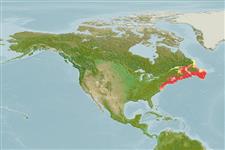Actinopterygii (ray-finned fishes) >
Perciformes (Perch-likes) >
Labridae (Wrasses)
Etymology: Tautogolabrus: Plural of the word "taut", an Indian Brazil name translated by Roger William from f the Narragansett, "tautauog" = sheepshead + Greek, labros = furious.
Environment / Climate / Range
Ecology
Marine; reef-associated; depth range 10 - 128 m (Ref. 5951). Temperate, preferred 7°C (Ref. 107945); 54°N - 36°N, 77°W - 48°W
Western Atlantic: Newfoundland and Gulf of St. Lawrence in Canada to Chesapeake Bay in USA.
Size / Weight / Age
Maturity: Lm ? range ? - ? cm
Max length : 38.0 cm TL male/unsexed; (Ref. 7251); max. published weight: 1.0 kg (Ref. 7251); max. reported age: 6 years (Ref. 1009)
Inhabits shallow, inshore waters, living on or near the bottom, often congregating in masses around wharves, wrecks and submerged seaweed. During winter they become torpid and remain inshore under rocks in shallow water (Ref. 5951).
Oviparous, distinct pairing during breeding (Ref. 205).
Robins, C.R. and G.C. Ray, 1986. A field guide to Atlantic coast fishes of North America. Houghton Mifflin Company, Boston, U.S.A. 354 p. (Ref. 7251)
IUCN Red List Status (Ref. 115185)
CITES (Ref. 94142)
Not Evaluated
Threat to humans
Harmless
Human uses
Aquarium: commercial
Tools
Special reports
Download XML
Internet sources
Estimates of some properties based on models
Phylogenetic diversity index (Ref.
82805): PD
50 = 1.0000 [Uniqueness, from 0.5 = low to 2.0 = high].
Bayesian length-weight: a=0.00871 (0.00431 - 0.01761), b=3.05 (2.88 - 3.22), in cm Total Length, based on LWR estimates for this species & (Sub)family-body (Ref.
93245).
Trophic Level (Ref.
69278): 3.7 ±0.2 se; Based on diet studies.
Resilience (Ref.
69278): Medium, minimum population doubling time 1.4 - 4.4 years (K=0.15-0.22; tmax=6).
Prior r = 0.95, 2 SD range = 0.68 - 1.32, log(r) = -0.05, SD log(r) = 0.17, Based on: 3 K, 1 tgen, 1 tmax, records
Vulnerability (Ref.
59153): Moderate vulnerability (43 of 100) .
